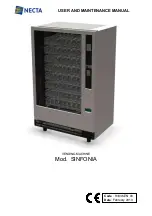Reviews:
No comments
Related manuals for Rose 605

Recover 12
Brand: Windsor Pages: 25

SINFONIA GF6
Brand: Necta Pages: 44

457K
Brand: Singer Pages: 4

PHC17F
Brand: PHC Pages: 4

Smoke 700 Magic
Brand: Audibax Pages: 2

FUTURA QUARTET SEQS-6000
Brand: Singer Pages: 112

FSM-150
Brand: EuroLite Pages: 38

1200D
Brand: Janome Pages: 91

KX-TG9472B
Brand: Panasonic Pages: 2

KX-TG9471B
Brand: Panasonic Pages: 2

KX-TG9345
Brand: Panasonic Pages: 2

KX-TG9331T
Brand: Panasonic Pages: 11

KX-TG9391
Brand: Panasonic Pages: 16

KX-TG9331T
Brand: Panasonic Pages: 26

KX-TG9372C
Brand: Panasonic Pages: 56

KX-TG9391
Brand: Panasonic Pages: 60

KX-TG9361B
Brand: Panasonic Pages: 60

KX-TG9541
Brand: Panasonic Pages: 88

















